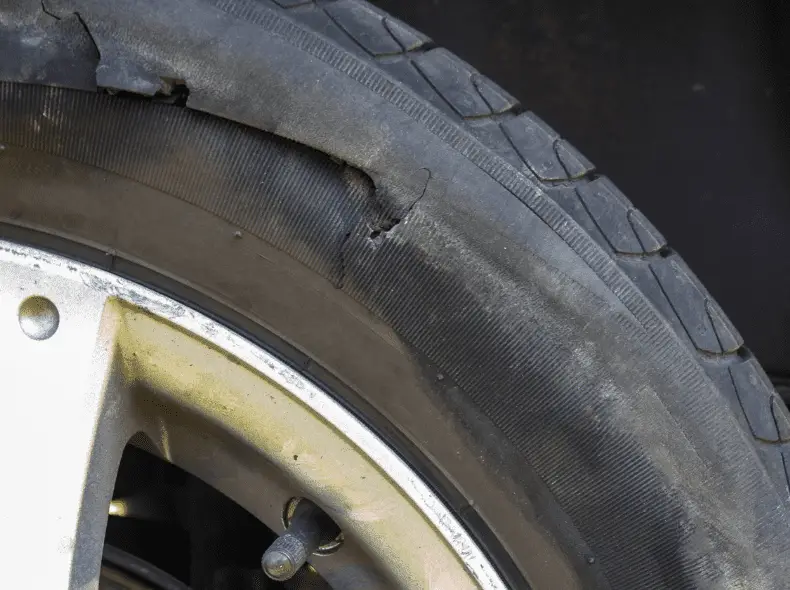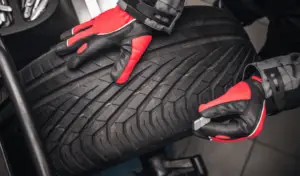Run-flat tires are a great safety innovation and are designed for you to drive on them when they are flat.
Remember that they are only designed to get you to a place of safety before they are repaired or replaced and are not a long term option when flat.
It is best to consult your vehicle manual to find out what they stipulate for your specific tire brand and vehicle. Generally, most tire brands state that a car that has a flat run flat tire should be driven at a speed not exceeding 50 mph and not for more than 50 miles.
As run flats are more expensive than standard tires, the temptation to drive for longer and faster on them will be there.
Surely paying extra for run flats means you can get additional use out of them? No, run flats are to allow you to drive your car to a safer area to get your tire repaired.
They stop the need to plug your tire at the roadside or replace it with a spare from the trunk.
The U.S. Tire Manufacturers Association (USTMA) advises vehicle owners to consult the tire manufacturer for its repair policy and, if applicable, recommended repair procedure.
Below I have put together extracts and links to some of the most popular tire manufacturers’ policies on driving on flat run flat tires:
Pirelli Tires Run Flat Repair Policy
“Manufacturers advise against repairing run flat tires because of the reinforced structure. In fact, the tire’s high level of resistance could make it hard to spot minor secondary damage, so there is a risk of only detecting the main damage and not effectively repairing the tire.
Generally speaking, punctured run flat tires should not be repaired but replaced,“
Pirelli Run Flat Repair Policy
Yokohama Tires Run Flat Repair Policy.
Yokohama calls their run flats ZPS (Zero Pressure System) tires.
“Yokohama recommends the slowest safe speed and the shortest distance to a service facility. Yokohama ZPS run flat tires are not to be repaired following a puncture or other tire disablement. “
Yokohama Tires Run Flat Repair Policy
Continental Tires Run Flat Tire Repair Policy
Continental call their run flats SSR, which stands for Self Supporting Run flat.
They state:
“Even a trained tire specialist may be unable to recognize internal structural damage to a Self Supporting Run flat (SSR) tire resulting from having been driven in an under inflated or zero pressure condition.
Such damage may not be visible on the surface of the inner liner or sidewall making it impossible to determine the tire’s suitability for repair. Continental does not recommend any repair to Continental SSR tires.”
Continental Run Flat Repair Policy
What Happens When A Run Flat Tire Goes Flat?
If you have a fully functioning TPMS system, you should be alerted that your tire is flat. The difference with a run-flat tire is that you can continue to drive; however, with a standard tire, you would have to stop and replace it or plug it at the roadside.
If the TPMS isn’t working, you may not immediately know if you have a flat, as the stiffer sidewall structure won’t bulge out like a conventional tire.
A flat run-flat tire is still damaged, and caution should be shown.
Sidewall Collapse
Continuing to drive could collapse the sidewall completely. This will be as serious as a standard tire going flat—the benefit of the run flat when the sidewall collapses has gone completely.

Steering Vague
A flat run flat tire will never be as responsive to a tire with air. Expect the steering to work well enough, but you’ll notice a slower reaction time and perhaps vibration in the steering wheel.
Suspension Stressed
Extra stress will be placed on the suspension supporting the damaged tire. The shock and bushes will be put under more strain as the tire does not absorb any of the road surface bumps.
Prolonged driving on flat run flat tires will require the car’s suspension to be inspected.
Run Flat Tires – How Far Can You Drive?
As run-flat tires drive on the reinforced sidewall, they can only be driven for a limited time and at a reduced speed. Almost all tire manufacturers recommend that the maximum mileage be 50 mph maximum speed of 50 mph.
Driving over and above this risks rupture in the reinforced sidewall, damaging the rim and putting the driver, passengers, and other road users at risk.
BMW Run Flat Tires – How Far Can You Drive?
BMW were one of the first car brands to embrace run-flat tire technology. Their website states
“Run-flat tires enable you to continue driving when you have a puncture. The Tire Pressure Monitoring device (installed on the vehicle) informs you of the puncture, but instead of stopping, you can drive on at a reduced speed, 50mph for 50 miles range.“
Conclusion
When flat run-flat tires can be driven on for 50 miles at no more than 50mph. Exceeding these can cause the side wall to collapse, damaging your car and causing a potential accident.
Run flat tires cannot be repaired because the tire has been running on the sidewall, which has been structurally compromised and is impossible to repair.





![How Fast Can You Go With Studded Tires? [Answered] stud-tires](https://carzaza.com/wp-content/uploads/2023/12/stud-tires-300x150.png)

![Minor Dry Rotted Tires [GUIDE] Tire-veins-dry-rot](https://carzaza.com/wp-content/uploads/2023/12/Tire-veins-dry-rot-300x150.png)





